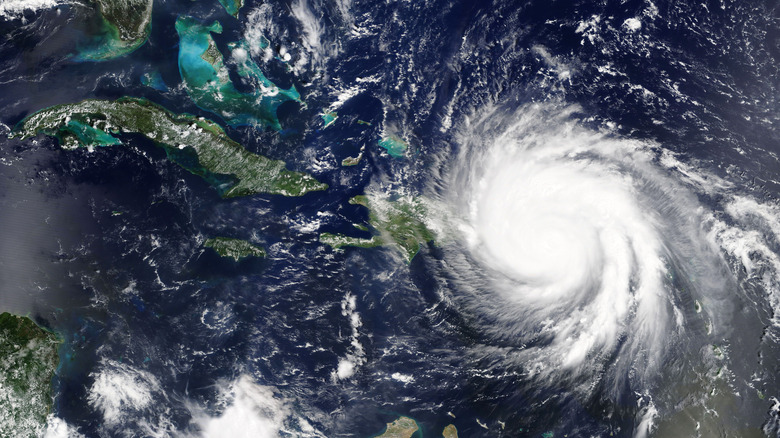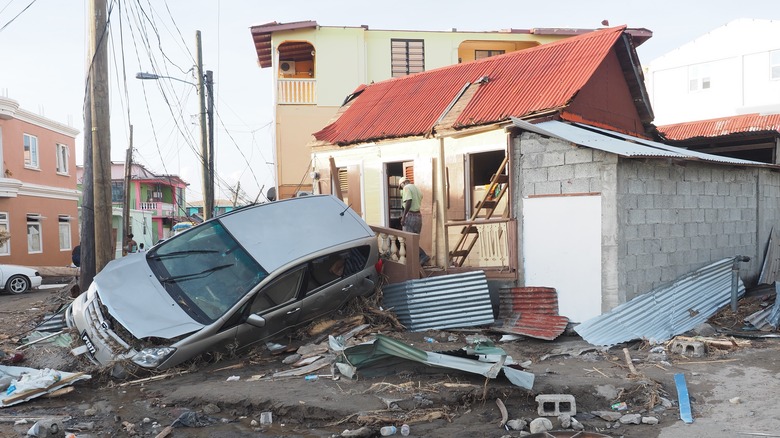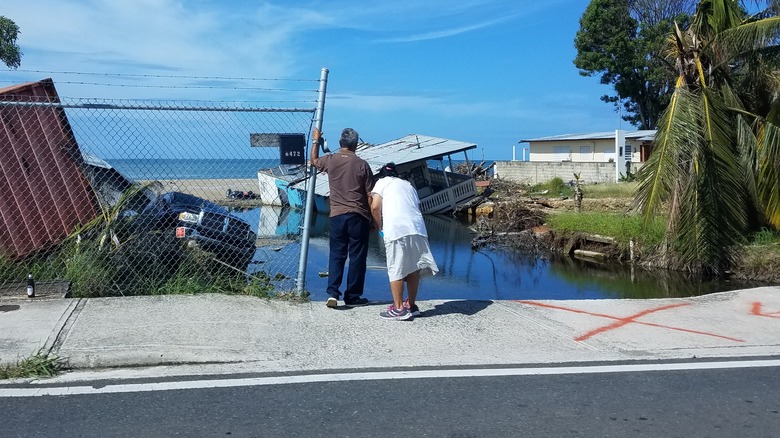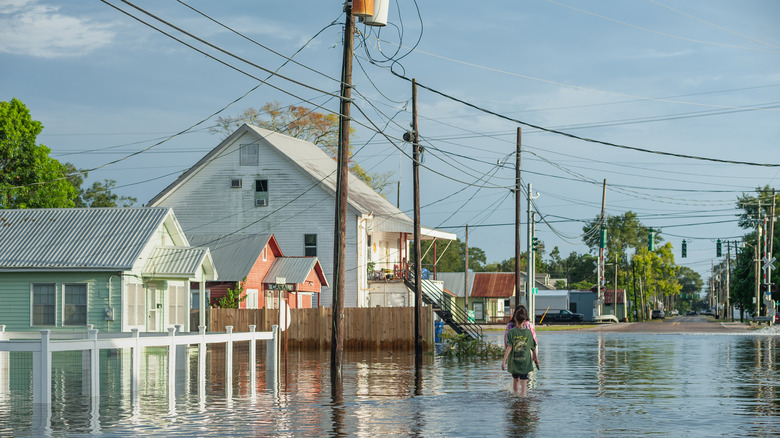Why Hurricane Maria's Death Total Is Surrounded By Controversy
In the early months of 2017, the Caribbean Island of Puerto Rico was surrounded on all sides — not only by water, but also by crises and misunderstandings. From mountain towns and rural establishments like Las Marias and Maricao to bustling metropolises such as San Juan and Bayamón, the roughly 3.2 million island residents (via Census) in the region were already teetering on the brink of economic collapse. According to Nature, at this point in history, almost half of the residents there, 44% of them to be precise, were surviving in crippling poverty. In fact, the government was about to make a bid for bankruptcy.
In addition to socioeconomic woe, a labor shortage, and a skilled worker exodus (per CNN Business), Puerto Rico also had to deal with being treated like a second-rate citizen of the United States of America. Relegated to the position of being neither a state nor an independent country (via History), Puerto Rico's political limbo was costing the territory its livelihood. Once the hurricane hit, it would go on to cost lives. The question is how many lives? Herein lies the controversy.
Hurricane Maria's original death toll was drastically undercounted
There seemed to be no way to downplay this astronomical storm. Hurricane Maria, the cyclone that swirled from coast to coast with Category 5 intensity, left massive, visible damage in its wake (via Hurricane Science). According to NBC News, Puerto Rico incurred $90 billion worth of damage, which is not to mention widespread displacement, daily blackouts that lasted months on end, and a massive hit to the island's already-strained infrastructure.
Yet, even as waist-high waters toppled stilted houses to the ground and vicious winds wreaked havoc on the power grid, the government managed to tell one of the darkest lies in history, by claiming the storm had caused only 64 casualties in total (per Nature). The wreckage alone was a testament to the fact that the death toll had to be much higher indeed. In a bitter twist of irony, the wreckage would also serve as the main reason the death toll would be difficult to tally.
Experts suspect that between 3,000 and 5,000 people died
Scientists and independent researchers tasked with exploring the wreckage for clues concur that the actual death toll from Hurricane Maria is likely somewhere between 3,000 and 5,000 casualties, according to Nature. The vagueness of this projection prompted one team to dig even deeper into the collapsing barrios for answers.
After an exhaustive undertaking of surveying thousands of households, a team of researchers from the FXB Center for Health and Human Rights at Harvard University pinpointed the true death toll to be closer to 4,645. This number takes into account the fact that the mortality rate rose by a whopping 62% in 2017, after the perilous storm hit (via FXB Center for Health & Human Rights).
The survey includes 3,299 participants undergoing household visits to create what researchers refer to as a "stratified random sample". The elaborate approach is similar to the way researchers tally casualties in warzones. Yet, despite months of laborious work, the number is still widely disputed and the death toll for Puerto Rico in wake of the disaster is considered a great controversy.
The number of confirmed casualties impacts the level of federal aid
It's easy to glance down at the rampant destruction of Hurricane Maria and not fully understand the importance the confirmed death toll has on people's lives in Puerto Rico. Not only do these numbers show researchers how severe a storm was, but according to Nature, they also tell governments how much money is needed to provide financial assistance, and figures also help determine which regions get a larger share of the pie. In other words, if the death count is off by a significant margin, it doesn't just mean undercounting the people that died. It also means underfunding the people that survived.
The initial undercount of Puerto Rico's Hurricane Maria casualties could be one of the many reasons that the island did not get the financial support it needed in a timely manner ... or at all. According to Harvard University's FXB Center for Health and Human rights, the island lacked aid to such an extent that the average resident went 68 days without running water and 84 days without electricity. What's more, unrepaired infrastructure damage cut off many people's access to healthcare, an unfortunate turn of events that led to even more death and destruction.
Accuracy vs. speed makes death counts a race against time
Superstorms tend to reveal the cracks in societies. There is something about a disaster-ridden infrastructure that makes hidden inequities visible. For example, one of the key things that made the death toll from Hurricane Maria difficult to tally in Puerto Rico was a lack of access to important things like healthcare, social services, and even death certificates (via Nature).
In addition to lost homes and missing documents, there are also multiple other approaches to arriving at a realistic figure. Oddly enough, those approaches did not crank out the same figure for the death toll in Puerto Rico. The discrepancies were often in the thousands. According to CNN, in 2018 the government of Puerto Rico officially declared the death toll to be 2,975, a number derived from a study authored by George Washington University researchers. And then, in December, The New York Times proclaimed the number of deaths caused by the hurricane was likely closer to 1,052, which the paper stated was the number of "excess deaths" that took place at the time.
As the number of estimated deaths caused by Hurricane Maria was hotly debated, lives were on the line. In a way, they still are.
What's at stake is about the future more than the past
On the surface, the death toll is a tally of destruction in the aftermath of a natural disaster like Hurricane Maria. It tells us things about the past, like which buildings were struck, which roads were fatally flooded, and how many people died because they didn't have access to a hospital. During the disaster, the figure has a massive impact on the present, giving global governments a better idea of where and if to send financial aid (per Nature).
Perhaps even more importantly, epidemiologist Debarati Guha-Sapir believes it can give us clues about who to protect most in future disasters, and that clue could potentially save thousands of lives. According to NPR, natural disasters like Hurricane Maria are now five times more likely to occur thanks to the imminent threat of climate change. Given those circumstances, agreeing on a fast and accurate way to divulge death counts could be a genuinely life-saving endeavor.
Notedly, some of the researchers who estimated the death toll in Puerto Rico put their lives on the line. Many of them withstanding the harsh conditions of being without power, cellular service, electricity, and other basic necessities — essentially suffering alongside the residents they were surveying, all in the name of making these counts more accurate in the future.





